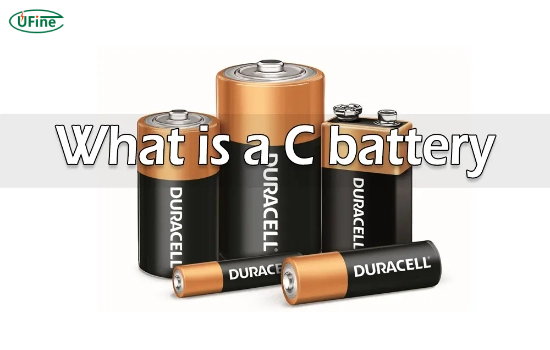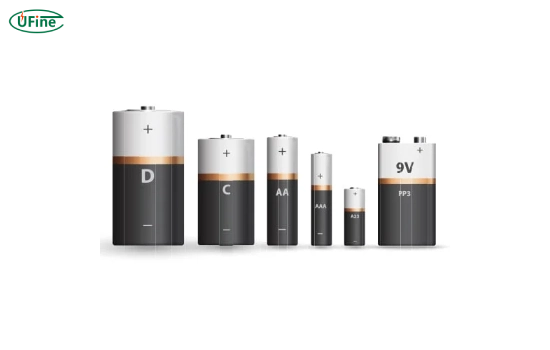C type batteries power various devices, from toys to flashlights. Their unique size and capacity make them a popular choice for applications that require moderate energy consumption. This guide will explore the different types of C type batteries, their advantages and disadvantages, and how they compare to other standard battery sizes. Understanding these aspects will help you make informed decisions when selecting the correct battery for your needs.
Part 1. What is a C type of battery?
A C type battery, also known as a C cell, is a standard-size dry battery commonly used in various devices. These cylindrical batteries are typically 50 mm long and 26.2 mm in diameter. They are larger than AA and AAA batteries but smaller than D batteries.
C type batteries are primarily used in applications that require moderate current draw, such as:
- Flashlights
- Toys
- Portable radios
- Musical instruments
Their design balances size and capacity, making them suitable for devices requiring longer runtime than smaller batteries.
Advantages of C Type Batteries
C type batteries offer several advantages, including:
- Versatility: They can power various devices, from toys to flashlights.
- Availability: C type batteries are widely available in stores and online, making them easy to replace.
- Cost-Effective: While rechargeable batteries may have a higher upfront cost, they can save money over time by reducing the need for frequent replacements.
- Performance: Many C type batteries, incredibly alkaline and lithium, provide reliable performance and long-lasting power.
Disadvantages of C Type Batteries
While C type batteries are popular, they also have some drawbacks:
- Environmental Concerns: Non-rechargeable batteries contribute to landfill waste. It’s essential to recycle them properly.
- Self-Discharge Rate: Some rechargeable batteries may lose charge over time, even when unused.
- Cost of Rechargeables: The initial investment for rechargeable batteries and chargers can be higher than disposable options.
Part 2. Types of C type batteries
C type batteries come in several chemistries, each with its characteristics and applications. The most common types include:
- Alkaline Batteries are the most widely used C type batteries. They offer good energy density and a long shelf life, making them ideal for everyday devices.
- NiMH (Nickel-Metal Hydride) Batteries are rechargeable and environmentally friendly. They can be reused multiple times, reducing waste. They have a lower voltage than alkaline batteries but are suitable for high-drain devices.
- Lithium Batteries Known for their lightweight and high energy density, lithium C type batteries are often used in high-performance devices. They have a longer shelf life and can operate in extreme temperatures.
- Zinc-carbon batteries are the least expensive option but have a shorter lifespan and lower energy density than alkaline batteries. They are suitable for low-drain devices.
Distinguishing Between Different Types of C Type Batteries
When choosing a C type battery, it’s essential to understand the differences between these types:
- Performance: Alkaline batteries perform best for most applications, while NiMH batteries excel in high-drain situations.
- Rechargeability: NiMH and lithium batteries are rechargeable, saving money over time and reducing waste compared to single-use alkaline batteries.
- Cost: Alkaline batteries are generally less expensive upfront, but rechargeable options may be more cost-effective in the long run.
Part 3. How to choose the right C type of battery?
When selecting a C type battery, consider the following factors:
- Device Requirements: Check the device specifications to determine the required voltage and current. Some devices perform better with specific battery types.
- Usage Frequency: For devices used frequently, rechargeable batteries like NiMH may be more economical in the long run.
- Shelf Life: If you need batteries for emergency use, opt for alkaline or lithium batteries with a longer shelf life.
- Environmental Impact: Consider using rechargeable batteries to minimize waste and reduce your carbon footprint.
Part 4. How to properly store C type batteries?
To ensure the longevity of your C type batteries, follow these storage tips:
- Keep in a Cool, Dry Place: High temperatures and humidity can affect battery performance.
- Store in Original Packaging: This helps prevent short-circuiting and protects the terminals.
- Avoid Mixing Battery Types: Using different types of batteries in the same device can lead to leakage or damage.
- Check Expiration Dates: Always use batteries before their expiration date for optimal performance.
Part 5. Typical applications of C type batteries
C type batteries are used in various applications, including:
- Toys: Many battery-operated toys require C type batteries for more extended playtime.
- Flashlights: C cells provide the necessary power for bright, long-lasting illumination.
- Musical Instruments: Some electronic instruments rely on C type batteries for portability.
- Portable Electronics: Devices like radios and speakers often use C type batteries for convenience.
Part 6. Comparing C type batteries with other common battery sizes
C type batteries are often compared to other battery sizes, such as D, AA, and AAA batteries. Here’s a breakdown of their differences:
| Battery Type | Size (mm) | Voltage | Common Uses |
|---|---|---|---|
| C | 50 x 26.2 | 1.5V | Toys, flashlights, radios |
| D | 61.5 x 33.2 | 1.5V | High-drain devices like large flashlights and portable speakers |
| AA | 50.5 x 14.5 | 1.5V | Remote controls, cameras, and small electronic devices |
| AAA | 44.5 x 10.5 | 1.5V | Small electronics like TV remotes and portable games |
Key Differences
- Size and Capacity: D batteries are larger and have a higher capacity than C batteries, making them suitable for devices that require more power. AA and AAA batteries are minor and typically used in low-drain devices.
- Voltage: All these batteries generally provide the same voltage (1.5V), but their capacity and energy density differ significantly.
- Applications: C batteries are ideal for moderate-drain devices, while D batteries are better for high-drain applications. AA and AAA batteries are used in everyday electronics that require less power.
Part 7. FAQs
-
What is the voltage of a C type battery?
A standard C type battery typically has a voltage of 1.5 volts for alkaline and zinc-carbon types. In comparison, rechargeable NiMH batteries have a nominal voltage of 1.2 volts. -
Can I use rechargeable batteries in place of alkaline C type batteries?
Yes, you can use rechargeable C type batteries in devices designed for alkaline batteries. However, be aware that the lower voltage of rechargeable batteries may affect performance in some devices. -
How long do C type batteries last?
The lifespan of a C type battery depends on its type and usage. Alkaline batteries can last 5 to 10 hours in high-drain devices, while rechargeable batteries may last 3 to 5 hours per charge. -
Are C type batteries safe to use?
Yes, C type batteries are generally safe when used as directed. However, avoid exposing them to extreme temperatures, moisture, or physical damage, which can lead to leakage or rupture. -
How should I dispose of C type batteries?
Always recycle C type batteries at designated recycling centers or drop-off locations. Many retailers offer battery recycling programs to help reduce environmental impact.
Related Tags:
More Articles

GoPro Battery Life Comparison: How Long Does a GoPro Battery Last?
Find out how GoPro battery life varies by model and get practical advice to maximize runtime for every adventure.
What Battery Powers Your GoPro?
Learn all about GoPro batteries - compatibility, runtime, charging tips, and how to extend battery life for longer shoots.
What Is a Disk Battery? A Simple Guide for Non-Tech Users
A disk battery is a small, round cell used in watches, remotes, and other electronic devices. It delivers steady power for compact, low-drain devices.
What Battery Powers a Space Heater?
Discover the type of battery that powers space heaters and learn how to choose the right one for efficient heating in your home or office.
What Is an LR14 Battery? Learn About This C-Size Cell
The LR14 battery, also known as a C battery, delivers steady power. Learn its specs, uses, lifespan, and how it compares to other battery types.





